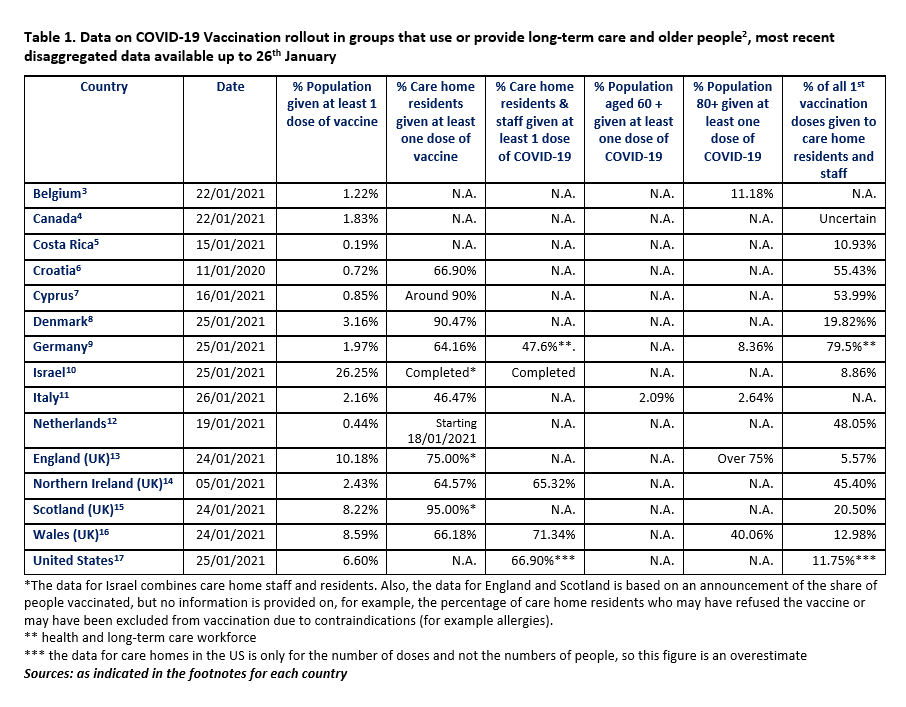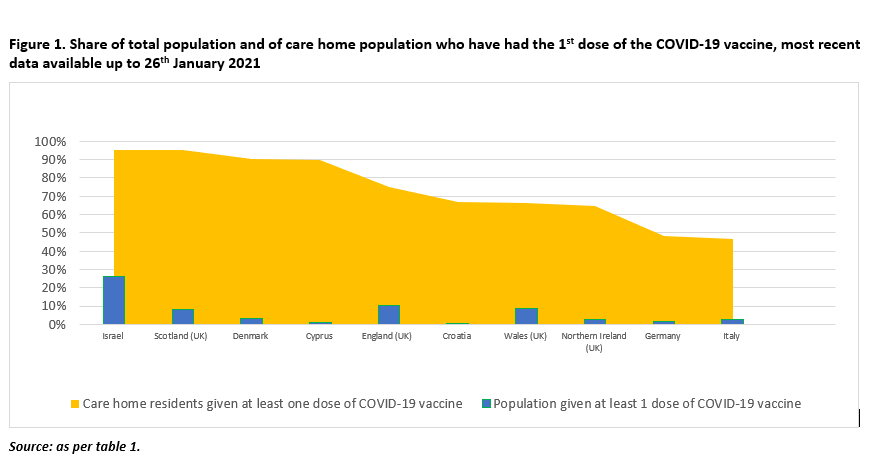Shoshana Lauter, Klara Lorenz-Dant, Adelina Comas-Herrera (Care Policy and Evaluation Centre, Department of Health Policy, London School of Economics and Political Science), Eleonora Perobelli (Observatory on Long-Term Care, CERGAS SDA Bocconi), Ann Caress (School of Human and Health Sciences, University of Huddersfield, UK), Samir K. Sinha (National Institute on Ageing, Ryerson University), Greg Arling (School of Nursing, Purdue University)
This report aims to provide an overview of data and policies in relation to COVID-19 vaccinations for people who use and provide long-term care. It is a “living report” that will be updated regularly, please email s.e.lauter@lse.ac.uk if you would like to contribute or aware of relevant sources of information. For the most up to date data on vaccination rollout for the entire population, please visit https://ourworldindata.org/covid-vaccinations.
Key findings:
- This report aims to provide an overview of progress in the delivery of COVID-19 vaccinations to people who use and provide long-term care. It is a collaborative “living report” that is updated and expanding regularly, please email s.e.lauter@lse.ac.uk if you would like to contribute.
- The report shows data on COVID-19 vaccinations for populations that either use and provide long-term care or are likely to do so. As of 26th January, these data are only available for a few countries, as most countries do not yet share disaggregated vaccination figures according to the characteristics of people who are vaccinated. In contrast, many countries provide data disaggregated by geographical area.
- An initial review of vaccine prioritization documents shows that care home residents and personnel are consistently listed among the group with the highest priority. Care partners and family members of care home residents and unpaid carers of people living in the community are only explicitly mentioned in a few countries. There are few mentions of people living with dementia or people with learning disabilities, although there is growing pressure in some countries (e.g. United Kingdom) for people with learning disabilities to be prioritised.
- On the 26th of January we have found data on COVID-19 vaccinations for LTC populations for 11 countries, but there are important problems with comparability, so the data in this report can only provide a broad indication of scale and is not suitable for detailed analysis.
- While most countries for which we have found data stated that care home residents were amongst the highest priority group, this does not necessarily translate into practice. In some countries the initial vaccination effort was entirely directed towards care homes, despite logistical challenges. So far, Israel, Denmark, Scotland and Cyprus, and some regions in Spain and Canada’s provinces have completed (or nearly completed) the 1st doses of vaccination of care home residents and staff, while England, Northern Ireland and Croatia, are close to achieving this goal too.
- There is marked contrast in the targeting of vaccinations, whereas some countries have initiated their vaccination rollout by targeting care homes, England, Germany, Italy and the United States have adopted a broader vaccination approach, targeting health care professionals and older people living in the community before care home residents and staff. This may be due to the logistical difficulties in delivering vaccines requiring very cold storage to care homes.
- This report also includes a summary of early (non-scientific) evidence on the international experiences in vaccination the LTC population:
- Countries are facing major challenges in respecting their rollout plans (in LTCFs and among the whole population) due to logistical challenges related to: on the one hand, the logistical challenges posed by some of the vaccines in terms of refrigeration and, on the other, the delay in the vaccine delivery announced by both Pfizer and AstraZeneca.
- There are also some indications of reluctance of part of LTC staff and, to a lesser extent, residents, to get vaccines.
- Finally, the need for consent policies for residents who lack capacity is another reason why it is more challenging to vaccinate people living in care homes, where a high proportion of residents have dementia, compared to older people living in the community.
The full report is available here:
Data on COVID-19 1st dose of vaccination rollout in groups that use or provide long-term care and older people (please see full report for sources, caveats, etc):


Suggested citation:
| Lauter S, Lorenz-Dant K, Perobelli E, Caress A, Sinha SK, Arling G, and Comas-Herrera A (2021) International “living” report: Long-Term Care and COVID-19 vaccination, prioritization and data. LTCcovid.org, International Long-Term Care Policy Network, CPEC-LSE, 26th January 2021. |
Next updated planned for: 2nd February 2021
Previous versions of the report are available here:

Pingback: Updated international report: Mortality associated with COVID-19 in care homes, data up to 26th January 2021 – Resources to support community and institutional Long-Term Care responses to COVID-19
Pingback: Mortality associated with COVID-19 outbreaks in care homes: early international evidence – Resources to support community and institutional Long-Term Care responses to COVID-19